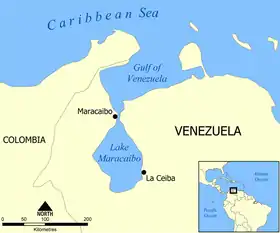Gulf of Venezuela
The Gulf of Venezuela is a gulf of the Caribbean Sea bounded by the Venezuelan states of Zulia and Falcón and by Guajira Department, Colombia. The western side is formed by the Guajira Peninsula. A 54 km (34 mi) strait connects it with Maracaibo Lake to the south.

Location
The Gulf is located in the north of South America, between Paraguaná Peninsula of the Falcón State to the east in Venezuela and Guajira Peninsula in Colombia to the west. It is connected to the south to Maracaibo Lake through an artificial navigation canal. Colombia and Venezuela have had a longstanding dispute over control of the gulf that has not been resolved, despite the decades-long negotiations conducted by a bilateral commission.
History
The gulf was first seen by Europeans in 1499, when an expedition commanded by Alonso de Ojeda, in which he was accompanied by Amerigo Vespucci, explored the Venezuelan coasts. They compiled information and named the new lands; this expedition arrived at the gulf after passing through the Netherlands Antilles and the Peninsula of Paraguaná.
Colombia and Venezuela have disputed the reach of their territorial waters in the gulf. This border dispute surged after the independence of Colombia and Venezuela from Spain in the first half of the 19th century. The Spanish empire did not delimit the area, because the Wayuu indigenous people posed resistance in this region. They were never subjugated. The land boundary was finally settled in 1941, but not the maritime.

Economic importance
These waters are important because they connect the Caribbean Sea to Lake Maracaibo in Venezuela, an important source of crude petroleum. Their industry uses the gulf to ship products from their wells and refineries in Lake Maracaibo to the world markets.